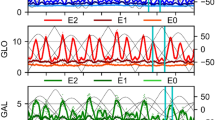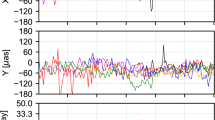Abstract
Homogeneously reprocessed combined GPS/GLONASS 1- and 3-day solutions from 1994 to 2013, generated by the Center for Orbit Determination in Europe (CODE) in the frame of the second reprocessing campaign REPRO-2 of the International GNSS Service, as well as GPS- and GLONASS-only 1- and 3-day solutions for the years 2009 to 2011 are analyzed to assess the impact of the arc length on the estimated Earth Orientation Parameters (EOP, namely polar motion and length of day), on the geocenter, and on the orbits. The conventional CODE 3-day solutions assume continuity of orbits, polar motion components, and of other parameters at the day boundaries. An experimental 3-day solution, which assumes continuity of the orbits, but independence from day to day for all other parameters, as well as a non-overlapping 3-day solution, is included into our analysis. The time series of EOPs, geocenter coordinates, and orbit misclosures, are analyzed. The long-arc solutions were found to be superior to the 1-day solutions: the RMS values of EOP and geocenter series are typically reduced between 10 and 40 %, except for the polar motion rates, where RMS reductions by factors of 2–3 with respect to the 1-day solutions are achieved for the overlapping and the non-overlapping 3-day solutions. In the low-frequency part of the spectrum, the reduction is even more important. The better performance of the orbits of 3-day solutions with respect to 1-day solutions is also confirmed by the validation with satellite laser ranging.










Similar content being viewed by others
Notes
Summaries of the analysis strategies for each AC can be found at http://acc.igs.org/reprocess2.html.
The draconitic year of a satellite represents the revolution period of the Sun with respect to its orbital plane.
The 3-day solution is the C3 solution defined in Sect. 3.
CODE, the Center for Orbit Determination in Europe, is a joint venture of the Astronomical Institute, University of Bern (AIUB), the Federal Office of Topography (swisstopo), the Bundesamt für Kartographie und Geodäsie (BKG), and the Institut für Astronomische und Physikalische Geodäsie, Technische Universität München (TUM).
Very Long Baseline Interferometry.
Doppler Orbitography and Radiopositioning Integrated by Satellite.
Summary of the analysis strategy: ftp://ftp.unibe.ch/aiub/REPRO_2013/CODE_REPRO_2013.ACN.
References
Altamimi Z, Collilieux X, Métivier L (2011) ITRF2008: an improved solution of the international terrestrial reference frame. J Geod 85(8):457–473. doi:10.1007/s00190-011-0444-4
Arnold D, Meindl M, Beutler G, Dach R, Schaer S, Lutz S, Prange L, Sośnica K, Mervart L, Jäggi A (2015) CODE’s new solar radiation pressure model for GNSS orbit determination. J Geod 89(8):775–791. doi:10.1007/s00190-015-0814-4
Beard RL (2014) The NAVSTAR 35 and 36 laser retro-reflector experiments. In: Proceedings from the 19th international workshop on laser ranging, Annapolis, US, 27–31 Oct 2014
Beutler G, Brockmann E, Hugentobler U, Mervart L, Rothacher M, Weber R (1996) Combining consecutive short arcs into long arcs for precise and efficient GPS orbit determination. J Geod 70(5):287–299. doi:10.1007/BF00867349
Brockmann E (1997) Combination of solutions for geodetic and geophysical applications of the Global Positioning System (GPS). Geodätisch-geophysikalische Arbeiten in der Schweiz 55, Eidg. Technische Hochschule Zürich, Switzerland
Bizouard C, Gambis D (2009) The combined solution C04 for earth orientation parameters consistent with international terrestrial reference frame 2005. Int Assoc Geod Symp 134:265–270. doi:10.1007/978-3-642-00860-3_41
Bizouard C, Gambis D (2011) The combined solution C04 for earth orientation parameters consistent with international terrestrial reference frame 2008. ftp://hpiers.obspm.fr/iers/eop/eopc04/C04.guide.pdf
Dach R, Hugentobler U, Meindl M, Fridez P (eds) (2007) The Bernese GPS Software Version 5.0. Astronomical Institute, University of Bern
Dach R, Brockmann E, Schaer S, Beutler G, Meindl M, Prange L, Bock H, Jäggi A, Ostini L (2009) GNSS processing at CODE: status report. J Geod 83(3–4):353–366. doi:10.1007/s00190-008-0281-2
Dick WR, Thaller D (eds) (2014) IERS annual report 2012. International Earth Rotation and Reference Systems Service. Central Bureau, Bundesamt für Kartographie und Geodäsie, Richard-Strauss-Allee-11, 60598 Frankfurt am Main, Germany, ISBN 978-3-86482-058-8
Dow JM, Neilan RE, Rizos C (2009) The International GNSS Service in a changing landscape of Global Navigation Satellite Systems. J Geod 83(3–4):191–198. doi:10.1007/s00190-008-0300-3
Gambis D (2004) Monitoring earth orientation using space-geodetic techniques: state-of-the-art and prospective. J Geod 78(4–5):295–303. doi:10.1007/s00190-004-0394-1
Gambis D, Luzum B (2011) Earth rotation monitoring, UT1 determination and prediction. Metrologia 48:S165–S170
Griffiths J, Ray JR (2012) Sub-daily alias and draconitic errors in the IGS orbits. GPS Solut 17(3):413–422. doi:10.1007/s10291-012-0289-1
Hefty J, Rothacher M, Springer TA, Weber R, Beutler G (2000) Analysis of the first year of Earth rotation parameters with a sub-daily time resolution gained at the CODE processing center of the IGS. J Geod 74(6):479–487. doi:10.1007/s001900000108
Meindl M (2011) Combined analysis of observations from different global navigation satellite systems. Geodätisch-geophysikalische Arbeiten in der Schweiz 83, Eidg. Technische Hochschule Zürich, Switzerland
Meindl M, Beutler G, Thaller D, Jäggi A, Dach R (2013) Geocenter coordinates estimated from GNSS data as viewed by perturbation theory. Adv Space Res 51(7):1047–1064. doi:10.1016/j.asr.2012.10.026
Pearlman MR, Degnan JJ, Bosworth JM (2002) The international laser ranging service. Adv Space Res 30(2):135–143. doi:10.1016/S0273-1177(02)00277-6
Petit G, Luzum B (eds) (2010) IERS Conventions (2010). Verlag des Bundesamtes für Kartographie und Geodäsie, Frankfurt am Main, Germany, IERS Conventions Centre
Press HW, Teukolsky SA, Vetterling WT, Flannery BP (1996) Numerical recipes in Fortran 77: the Art of Scientific Computing, 2nd edn. Cambridge University Press, Cambridge
Ray J, Altamimi Z, Collilieux X, van Dam T (2008) Anomalous harmonics in the spectra of GPS position estimates. GPS Solut 12(1):55–64. doi:10.1007/s10291-007-0067-7
Ray J, Griffiths J, Collilieux X, Rebischung P (2013) Subseasonal GNSS positioning errors. Geophys Res Lett 40(22):5854–5860. doi:10.1002/2013GL058160
Rebischung P, Garayt B, Altamimi Z, Collilieux X (2015) The IGS contribution to ITRF2014. Presented at the 26th IUGG General Assembly, Prague, http://acc.igs.org/trf/Rebischung-IUGG2015.ppt. 28 June 2015
Sośnica K, Thaller D, Dach R, Jäggi A, Beutler G (2013) Impact of loading displacements on SLR-derived parameters and on the consistency between GNSS and SLR results. J Geod 87(8):751–769. doi:10.1007/s00190-013-0644-1
Sośnica K, Thaller D, Dach R, Steigenberger P, Beutler G, Arnold D, Jäggi A (2015) Satellite laser ranging to GPS and GLONASS. J Geod 89(7):725–743. doi:10.1007/s00190-015-0810-8
Springer TA, Beutler G, Rothacher M (1999) A new solar radiation pressure model for GPS satellites. GPS Solut 3(2):50–62
Steigenberger P, Rothacher M, Dietrich R, Fritsche M, Rülke A, Vey S (2006) Reprocessing of a global GPS network. J Geophys Res 111:B05402. doi:10.1029/2005JB003747
Steigenberger P, Hugentobler U, Lutz S, Dach R (2011) CODE contribution to the first IGS Reprocessing Campaign. IAPG/TUM Technical Report 1/2011, http://www.bernese.unibe.ch/publist/2011/artproc/CODE_Repro1.pdf
Acknowledgments
This analysis would not have been possible without the raw data and the products made available by the ILRS (Pearlman et al. 2002) and the IGS (Dow et al. 2009). Extensive use was made, as well, of the combined space-geodetic solutions for the EOPs generated by the IERS (Dick and Thaller 2014). This coordinating and combination work is gratefully acknowledged.
Author information
Authors and Affiliations
Corresponding author
Rights and permissions
About this article
Cite this article
Lutz, S., Meindl, M., Steigenberger, P. et al. Impact of the arc length on GNSS analysis results. J Geod 90, 365–378 (2016). https://doi.org/10.1007/s00190-015-0878-1
Received:
Accepted:
Published:
Issue Date:
DOI: https://doi.org/10.1007/s00190-015-0878-1




